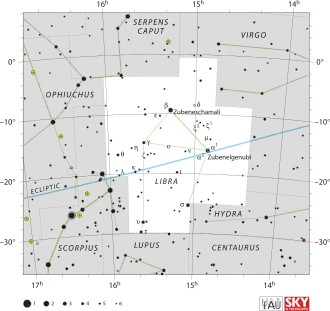Ypsilon Librae
| Doppelstern Ypsilon Librae | |||||
|---|---|---|---|---|---|
 | |||||
| Beobachtungsdaten Äquinoktium: J2000.0, Epoche: J2000.0 | |||||
| AladinLite | |||||
| Sternbild | Waage | ||||
| Rektaszension | 15h 37m 1,4502s | ||||
| Deklination | -28° 08′ 06,2926″ | ||||
| Astrometrie | |||||
| Radialgeschwindigkeit | −24.9 ± 0.7 km/s | ||||
| Parallaxe | 14.58 ± 0.19 mas | ||||
| Entfernung | 224 Lj (68.6 ± 0.9 pc) | ||||
| Einzeldaten | |||||
| Namen | A; B | ||||
| Typisierung: | |||||
| B−V-Farbindex | A | +1,374 | |||
| U−B-Farbindex | A | +1,586 | |||
| Physikalische Eigenschaften: | |||||
| Masse | A | 1.67 M☉ | |||
| B | |||||
| Leuchtkraft | A | 309 L☉ | |||
| B | |||||
| Effektive Temperatur | A | 4,135 ± 20 K | |||
| B | |||||
| Metallizität [Fe/H] | A | -0.02 | |||
| B | |||||
| Alter | 3.14 Jahrmilliarden | ||||
| Andere Bezeichnungen und Katalogeinträge | |||||
| |||||
Ypsilon Librae (υ Lib, υ Librae) ist die Bayer-Bezeichnung für einen Doppelstern[1] im Tierkreis-Sternbild Waage. Mit einer scheinbaren Helligkeit von 3,628,[2] ist er mit dem bloßen Auge sichtbar. Die Entfernung zu diesem Stern, basierend auf einer jährlichen Parallaxenverschiebung von 14,58,[3] beträgt etwa 224 Lichtjahre. Er hat einen Begleitstern der Helligkeit 10,8 in einem Winkelabstand von 2,0 Bogensekunden bei einem Positionswinkel von 151°, (Stand 2002).[4]
Die hellere Komponente ist ein entwickelter K-Typ-Riesenstern mit der stellaren Klassifikation K3 III.[5] Der gemessene Winkeldurchmesser, nach Korrektur der Randverdunkelung, beträgt 4,27±0,05 mas.[6] Bei der geschätzten Entfernung des Sterns ergibt dies eine physikalische Größe von etwa 31,5 mal den Radius der Sonne.[7] Er hat die 1,67-fache Masse der Sonne und strahlt bei einer effektiven Temperatur von 4.135 K die 309-fache solare Leuchtkraft aus seiner äußeren Atmosphäre ab.[8] Der Stern ist etwa drei Milliarden Jahre alt.[8]
Einzelnachweise
- P. P. Eggleton, A. A. Tokovinin: A Catalog of Multiplicity among Bright Stellar Systems. In: Monthly Notices of the Royal Astronomical Society. Band 389, Nr. 2, 11. September 2008, S. 869–879, doi:10.1111/j.1365-2966.2008.13596.x.
- L. Celis S.: Photoelectric photometry of late-type variable stars. In: Astronomy and Astrophysics Supplement Series. Band 22, Oktober 1975, ISSN 0365-0138, S. 9–17.
- F. van Leeuwen: Validation of the new Hipparcos reduction. In: Astronomy and Astrophysics. Band 474, 1. November 2007, ISSN 0004-6361, S. 653–664, doi:10.1051/0004-6361:20078357.
- Brian D. Mason, Gary L. Wycoff, William I. Hartkopf, Geoffrey G. Douglass, Charles E. Worley: The 2001 US Naval Observatory Double Star CD-ROM. I. The Washington Double Star Catalog. In: The Astronomical Journal. Band 122, 1. Dezember 2001, ISSN 0004-6256, S. 3466–3471, doi:10.1086/323920.
- N. Houk: Michigan Catalogue of Two-dimensional Spectral Types for the HD stars. Volume_3. Declinations -40_f0 to -26_f0. In: Michigan Catalogue of Two-dimensional Spectral Types for the HD stars. Volume_3. Declinations -40_f0 to -26_f0., by Houk, N.. Ann Arbor, MI(USA): Department of Astronomy, University of Michigan, 12 + 390 p. 1982.
- A. Richichi, I. Percheron, M. Khristoforova: CHARM2: An updated Catalog of High Angular Resolution Measurements. In: Astronomy and Astrophysics. Band 431, 1. Februar 2005, ISSN 0004-6361, S. 773–777, doi:10.1051/0004-6361:20042039.
- Kenneth Lang: Astrophysical Formulae: Volume I & Volume II: Radiation, Gas Processes and High Energy Astrophysics / Space, Time, Matter and Cosmology. Springer Science & Business Media, 2006, ISBN 978-3-540-29692-8 (google.de [abgerufen am 17. April 2021]).
- R. Earle Luck: ABUNDANCES IN THE LOCAL REGION. I. G AND K GIANTS. In: The Astronomical Journal. Band 150, Nr. 3, 25. August 2015, ISSN 1538-3881, S. 88, doi:10.1088/0004-6256/150/3/88.